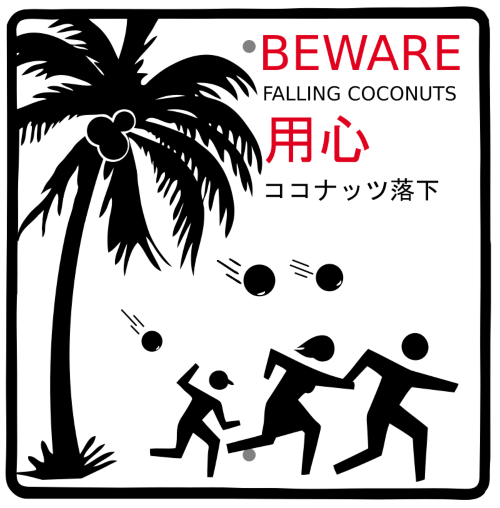Is Death From Coconuts A Myth, Or A Danger Above Our Heads?
A few years ago, I was on a trip to Thailand. At one point, we reached a tropical forest on an exotic island. Then it happened. I saw them staring at me and screamed at the top of my lungs. “What? What happened?” asked the tour guide, “Is there a snake here? A local gang? A serial killer dressed as a lady boy?”. With a trembling hand, I shook my head in the negative and pointed at the tall coconut trees above our heads. “Co..co…coconut”, I stammered. “I read that each year, there are something like 150 deaths from coconuts that fall on people from trees.” The guide looked at me with a lingering look for a few seconds, then started laughing. “Oh, well. You don’t believe this nonsense, do you? Don’t be silly, because…”.
The tour guide was unable to finish the sentence because, at that very moment, a considerable coconut fell on his head and crushed him. The sight was horrifying, something that looked like a combination of coconut juice, blood, and internal organs. I looked at the stunned group members. “I told you that coconuts are dangerous?” I said in a knowledgeable tone. “Does anyone want a smoothie?”.
Although death from coconuts is relatively rare, its consequences can be devastating, so raising awareness of this issue is essential. In the following article, we will investigate this surprising phenomenon in depth, analyze why a falling coconut can be so dangerous, examine the regions where the phenomenon is more common, and explain some precautions to reduce the risk.
Death By Coconuts: Fact, Or Dubious Myth?
When we think of coconuts, the first image that comes to mind is sitting on a tropical beach with coconut juice, a smoothie, or some other delicious food. Others will bring before their eyes the complex discussion regarding its health aspect, which also varies according to the form of its consumption. According to some perceptions, the virtues of the coconut fruit – which explain why it is called “the fruit of life” in some cultures – include, for example:
🥥 An impressive amount of vitamins
🥥 Assistance in balancing blood sugar levels
🥥 balancing cholesterol levels
🥥 Strengthening the immune system
🥥 Improving the digestive process
🥥 Improving energy and mood
On the other hand, some argue that consuming coconut can be harmful, especially in large quantities. For years there has been a debate, for example, whether coconut oil is healthy, or “pure poison”, as some experts suggested. The claim is that the impressive amounts of saturated fat in coconuts can cause clogging of the arteries and increase the risks of serious diseases. In addition to the serious long-term consequences, drinking coconut in moderate to high quantities can also cause sudden death – this is due to cardiac arrest caused by hyperkalemia (excess potassium in the blood).

💀 Killer Deals & Scary Recommendations 💀
🎭 Costumes & Accessories
HalloweenCostumes Fun Costumes Entertainment Earth
🛒 Online Shopping
AliExpress Amazon Walmart Etsy
🧛 Collectibles & Horror Brands
Funko Hot Topic Lego Spirit Halloween
🎢 Attractions & Tours
GetYourGuide Tiqets Viator Klook
📖 Blogs & Horror Sites
Bloody Disgusting iHorror Fangoria
🩸 Disclaimer: Some links are affiliate links. The price stays the same – it just helps keep the site alive 👻
How Many People Die From Falling Coconuts Each Year?
With all due respect, we are not here to talk about eating coconut but about the moments when our nature becomes especially scary. We will refer to a slightly less dangerous phenomenon but one that stars in almost every list of the strangest causes of death in the world. Death from coconuts describes a situation in which people die, or at least are poorly injured, by the fact that a coconut falls on their body, most of the time their head. It is difficult to estimate precisely what the number of people who die in this way is, with estimates talking about something like 150-130 people. The main question is whether these numbers of death by coconuts are accurate or an urban legend that started a few decades earlier.
One of the reasons for this claim that the numbers suggesting how many people are killed by falling coconuts per year are inaccurate is the legitimacy of the research with these claims. In 1984, a study by Dr. Peter Barss – a doctor at a public hospital in Papua New Guinea – presented the problem. In the study, with the surprising name “Injuries Due to Falling Coconuts,” Dr. Barss claimed that over four years, about 2.5% of admissions to trauma wards were due to falling coconuts and presented two earlier deaths from coconuts.
For some reason, and probably incorrectly, his figures over time became a myth about 150 annual deaths, perhaps assuming that elsewhere in the world, there would be a rate similar to fatalities. Barss was scorned and received in 2001 the “Ig Nobel Award” – a humorous prize that is a kind of parody of the Nobel Prize and is awarded every year to scientists (and other experts, apparently or not) who conduct strange research that “makes you laugh, and then think.” In short, “studies that do not need to be replicated.” Barss didn’t like the joke and claimed, “When you’re treating these injuries daily, it’s not funny at all.”
Do More People Die From Coconuts Or Sharks?
Even if Barss’s numbers are inaccurate, they had their effect. In the years that followed, claims spread, primarily exaggerated, about deaths related to falling coconuts. Critics defined the reports as an “urban legend“, or “journalistic equivalent of a contemporary legend”. Some used the myth for their purposes, such as a company that marketed travel insurance to Papua New Guinea and presented in an ad the danger from coconuts, “which are ten times more dangerous than sharks.”
The comparison between sharks and coconuts is not a coincidence. In 2022, similar quotes appeared from the director of the International Shark Attack File, George H. Burgess, who compared types of death from a coconut and a shark attack. He cited the number of 150 deaths from evil coconuts and compared it to only about 5 deaths due to shark attacks per year. In other words, many more people die from falling coconuts than shark attacks. In this case, too, there are various misunderstandings about these numbers, including the claim that the number of shark deaths is actually higher.
While there are more common strange causes of death rather than death from coconuts (for example, suffocation during sex, falling out of bed, or being killed by a hippopotamus), the numbers based on them may be slightly inflated. But there is no doubt that we should have some awareness about the danger of deaths by falling coconuts. Nevertheless, at least several hundred cases of this kind of brutal death are known, starting from the 18th century or so until recent years.

How Can Coconuts Kill You?
To understand the dangers of coconut in the current context, it is enough to examine the characteristics of the fruit and the tree it grows on – a coconut tree, or in its full name, “Cocos nucifera,” which belongs to the palm tree family. A mature coconut usually weighs about 1-2 kilograms but can also reach about 4 kilograms. It may sound light, but that weight can be devastating when falling from a great height. The coconut further stands out for its hard outer shell, where most of the weight may be concentrated in a relatively small impact point due to the shape of the coconut. Such a shape may increase the force of the blow and the potential damage.
According to the well-known theory, Isaac Newton got the idea of gravity after an apple fell next to him while he was sitting under a tree. Suppose he had sat under a coconut tree and experienced a direct impact of the coconut fruit. In that case, he may not be here to develop some critical theories in science, mathematics, and more. The falling of the coconut fruit is dangerous since the fruit falls from a great height. Coconut trees can reach a height of about 30 meters, which means that the fruit falling from such a height gains significant acceleration that increases its strength. Since a fruitful coconut tree may produce about 75 fruits (the average is around 30 fruits), it is clear why many fruits may fall here, increasing the chances of death by coconuts.

The page is short here from going into physical calculations. What’s more, the writer of these lines has yet to gain an actual knowledge of the subject. In general, considering the fall’s impressive height, a coconut’s speed when it reaches the ground – or hits a person’s head – can get about 50 kilometers per hour, even more. The energy of the fruit in this situation will be high enough (several hundred joules) to cause a fatal impact, even more than a baseball, for example, thrown into the atmosphere at high speed.
In extreme cases, coconuts falling on people’s heads or bodies can cause horror scenarios such as damage to the back, neck, or shoulders, skull fractures, cerebral hemorrhage, or even immediate death. On the more optimistic side, it’s important to remember that not every coconut hit actually results in these results. Various variables, such as the tree’s height, the fruit’s weight, the angle of impact, the affected limb, and luck, also play a role here. Nevertheless, it is crucial to know the danger, be aware, and take basic precautions, as we will see later.

Afraid Of A Falling Coconuts? These Are The Locations You Should Avoid
Unlike many other trees, it is difficult to determine the coconut tree’s origin unequivocally. A standard theory says that the tree came from Southeast Asia, but some believe it originated in South America. Evidence shows that coconut trees were in other places, such as New Zealand or India, as early as 15 million years ago.
Following this, coconut trees are growing in many places worldwide. Coconut trees require tremendous precipitation (about 750-2,000 mm per year) and high humidity (about 70-80%), and many locations have these conditions.
Beyond the geographical distribution, there are places where the danger of coconut fruits is more severe than others due to factors related to the size of the coconut trees, the weather (strong winds and tropical storms may increase the chances of a coconut falling), tree maintenance, tourism, etc. Among the disaster-prone areas, in terms of death from coconuts, are:
🌴 Southeast Asia – countries like Thailand (aha aha!), Indonesia, and Malaysia are in high places in the incidence of death from falling coconuts, partly due to a high density of trees, a tropical climate that encourages their rapid growth and extensive tourism, which increases the number of potential victims
🌴 Island countries in the Indian and Pacific oceans, such as the Maldives and Sri Lanka, due to the density of coconut trees, proximity between the residential and growth areas, an extensive coconut industry, etc.
🌴 The Caribbean islands (for example, Jamaica or Barbados) due to the extensive tourism and the widespread use of coconuts, which is reflected in an impressive number of trees
🌴 The beaches of Brazil, mainly on the northeastern side of the country, also due to the combination of the concentration of coconut trees and extensive tourism
🌴 Australia, mainly the Queensland region. The authorities decided to remove coconut trees from the beaches, trying to reduce the danger

How Can You Prevent Death From Coconuts Falling?
Although death from coconuts falling from trees is relatively rare, statistics show that it can happen. On the bright side, there are some pretty basic precautions you can take to reduce your chances of becoming one of the grim statistics:
🥥Awareness – be aware of the environment you are in, and especially of the presence of coconut trees. Especially in forests, beaches, and resort areas
🥥Location – want to rest under a tree? It might be better to sit under a vine or a fig tree. It would be best if you did not sit or lie directly under a coconut tree
🥥 Vigilance – try to be suspicious of unruly coconuts falling, especially in complex conditions, such as strong winds that increase the chances of falling
🥥 Caution – coconut is a delicious fruit, but you should avoid climbing coconut trees or picking coconuts independently.
On the other hand, we can take action at the local or even institutional level, such as regular maintenance of coconut trees (mainly pruning of branches and ripe fruits), removal of trees from buildings, warning signs, etc.
So the next time you visit a tropical forest or walk near coconut trees, occasionally look up. Please beware of the falling coconut sign because it is there for a reason. It could save a life.




